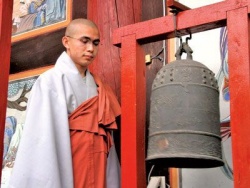Difference between revisions of "Sunim"
Jump to navigation
Jump to search
| Line 1: | Line 1: | ||
[[File:Koreamonk.jpeg|thumb|250px|]] | [[File:Koreamonk.jpeg|thumb|250px|]] | ||
| − | Sunim is the Korean title for a Buddhist monk or Buddhist nun. It is considered respectful to refer to senior monks or nuns in Korea as Kun sunim. In most Korean temples, a middle-aged monk assumes the role of a juji sunim, who serves administrative functions. The eldest sunim is typically seen as a symbolic leader of the younger sunims. | + | [[Sunim]] is the [[Korean]] title for a [[Buddhist monk]] or [[Buddhist nun]]. It is considered respectful to refer to {{Wiki|senior}} [[monks]] or [[nuns]] in [[Korea]] as Kun [[sunim]]. In most [[Korean]] [[temples]], a middle-aged [[monk]] assumes the role of a juji [[sunim]], who serves administrative {{Wiki|functions}}. The eldest [[sunim]] is typically seen as a [[symbolic]] leader of the younger sunims. |
{{W}} | {{W}} | ||
Latest revision as of 11:54, 24 September 2013
Sunim is the Korean title for a Buddhist monk or Buddhist nun. It is considered respectful to refer to senior monks or nuns in Korea as Kun sunim. In most Korean temples, a middle-aged monk assumes the role of a juji sunim, who serves administrative functions. The eldest sunim is typically seen as a symbolic leader of the younger sunims.
